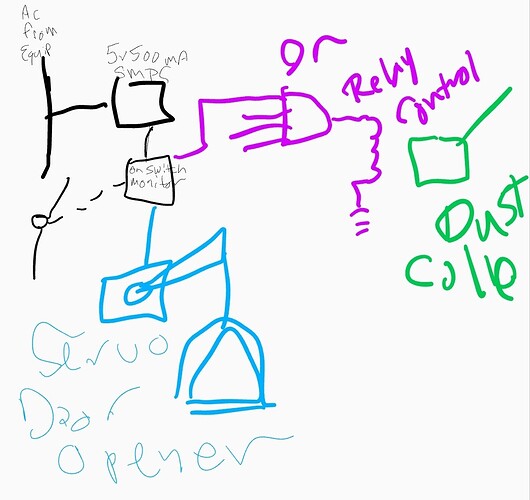I wonder if we should add hardwired switches to the dust collector. It isn’t like we move the equipment around all the time.
The issue I see with that is if they are typical on/off switches, a person might need to go around and check all of them to find all of the ones that are on. A hardwired system that works like the existing remotes can be out together pretty easily, with multiple switches engaging or disengaging a common relay, but it’s not as simple to lay out. The existing remotes have always been a little finicky though. Some need a serious debounce circuit in them, it seems!
Debounce is easy.
Let me think a bit on the n number of control switches. It seems suspiciously easy. But I want to test a theory first.
Even a Nano would be sufficient to decide whether you’re turning the system on or off, and make it happen via relay. And yeah, debounce is a given and pretty trivial to code.
If I was going to use an uC I’d use an attiny85.
I was thinking button events being sent to an or gate to run the relay. There is a trivial latching circuit that is like a mosfet and a transistor.
There are batteries in the front office.
I’ve got about a dozen attiny85 SMDs…do they even come in a DIP package?
Heck Yea! I have a half dozen of them in dip
So I think we can get 500 ma 5v switch mode power supplies and hook up logic to the equipment on switch. If the switch comes on a servo lifts up the baffle door, and pulls a signal high. That signal goes to an or gate that controls the dust collector.
So if ANY of the connected equipment is on the dust collector is running.
Here is a picture that may or may not clar6my word salad.
We have the ics for this in the ERP if we just use TTL.
I don’t like the idea of tying operation of the dust collector to the equipment running. Doing so would multiply the number of start/stops the dust collector goes through. Adding a delay helps with that but I think it’s better to be able to just turn the dust collector on and let it run until the job is done.
Somewhere this conversation turned to greek, I didn’t understand anything passed dust collector, haha.
This is the circuit I would try first for the button push. If I get a chance I’ll try it on sparky (my breadboard) if it works we can order 30 boards and have them wired up lickety split.
https://www.edn.com/latching-power-switch-uses-momentary-pushbutton/
Or just buy latching buttons I guess.
I moved this to a separate topic.
Latching switches don’t seem like a great idea to me (especially if they come from Wish…). If someone leaves one on you would have to hunt it down if it was separate from machine power. I would probably send a signal to a long (10+ minute) timer that constantly resets while any of the machines are on. Then maybe add a single off button by the dust collector or the door so it could be turned off manually when everyone leaves. That would make it a lot harder for people to turn it on/off frequently. Sometimes I hear it cycling every few minutes. The lasers are set up with a couple optocouplers going into the trigger for a timer module, and that has worked nicely so far.
If you wired momentary pushbuttons in parallel then you could have one of those latching circuits and be able to turn it on and off at any button.
And I ordered some of those switches and I’m going to use them EVERYWHERE
Separate extension cords, all wired in parallel to the dust collector. Just plug in the one near where you’re working. Boy, you guys sure complicate stuff. 

Before someone points out that all of the other plugs would be hot when any one is plugged in…we’d put up a sign. Safety first.
Simple mechanical timer switch maybe?
Just turn it if you forget to shut it off it will turn its self off
Sure, but if you’re going through the trouble of wiring up new switches, it’s probably worthwhile to consider ways to reduce undesirable behavior like short cycling and running tools without the dust collection on.
